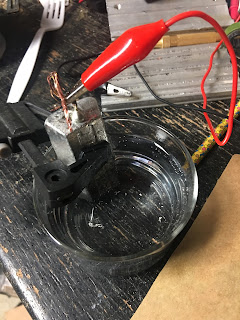Electroplating works by dipping the material to be plated in a solution and running electricity through the solution to move metal to coat the material. To tin plate copper, the positive terminal of the battery is connected to the tin and the negative is connected to the copper. The solution has tin dissolved in it. Sugar is added as a brightener.
Note: Caution must be taken when handling acid and when working with electricity. Wear protective equipment (such as gloves, goggles, respirator, etc. and use care in handling materials. Vapors may be harmful as well so avoid inhaling vapors and only work in an environment with good ventilation.
This is how I did it. Follow at your own risk.
Steps:
Materials: pure tin (ingot or solder), an acid, alligator leads, sugar, a battery, a non-conductive container, and the material to be plated - copper bus bar or connectors.
1. I dissolved some shavings of the tin in muriatic acid (hydrochloric acid). I only used 2 ounces of acid. I let it sit for an hour. It started bubbling immediately. The fumes smelled bad possibly toxic.
2. I added distilled water approx 5 parts to 1 part of the solution from previous step.
3. I Added some sugar to the solution as a brightener. I used about a tablespoon for a 2 cup glass.
4. I Attached the positive terminal of the battery to the tin and placed on one side of a glass container containing the solution. 2 D cell batteries connected is series makes 3 volts.
 |
| Positive terminal connected to tin ingot in solution |
6. Attached the negative terminal to the copper bus bar using alligator clip leads. Once this was connected, the circuit was complete and electroplating started and noticed bubbles.
7. After a couple of minutes, I removed the copper and rinsed it off. Then removed some scale from the plated area. Then plated the area a second time.
 |
| Here is the end result, tin plated bus bars |
http://transistor-man.com/electroplating_busbar.html
http://hackaday.com/2012/10/14/diy-tin-plating-for-bus-bars/
http://www.sharrettsplating.com/blog/the-tin-plating-process-a-step-by-step-guide/
I wanted to thank you for this great Information and knowledge, I definitely loved every little bit of it. I have you bookmarked your web site to check out the latest stuff you post. Your blog is eye-catching. I get pleasure from it. Thanks for sharing this beautiful piece of writing with me, get more information at Silver Plating Service for more Astfinishing.com related information and knowledge.
ReplyDelete